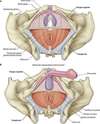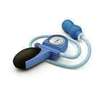Episiotomy and perineal tear: prevention and treatment
The after-effects of childbirth are part of the taboo subjects that we don't talk about at a dinner party and yet if this were the case, fewer women would suffer in silence and fewer couples would be torn apart... This is the reason why I decided to write this article, intended for women as well as men, to inform but also advice to prevent but also to relieve this problem.
Enjoy reading and share with others.
Basics : the anatomy of the perineum
The perineum is well known in women, and yes, all of them know that they will have to do a perineal rehabilitation after childbirth. But did you know that men also have a perineum?
And yes, the perineum is a set of muscles, ligaments and membranes. In the shape of a diamond, its role is to close the lower part of the pelvis. It acts like a hammock and maintains the gynecological, visceral and urinary spheres.

The muscles of the perineum
We distinguish the anterior perineum and the posterior perineum:
- the anterior perineum or urogenital perineum
- the posterior perineum or anal region
The perineum is formed by two planes:
Deep plane of the perineum
It is composed of 2 muscles:
- elevator muscle of the anus
- coccygeal muscle
Superficial plane of the perineum
- Transverse perineal muscle
- External sphincter of the urethra
- Cavernous ischium muscle
- Bulbous spongiosa muscle
- Constrictor muscle of the vagina (in women)
The role of the perineum
By keeping the lower pelvic orifice closed, the perineum is involved in the gynecological, urinary and visceral spheres.
- Support of the organs, balance of the pressures coming from the abdomen, support of the body weight
- Urinary and fecal continence: a well-functioning perineum allows the sphincters to remain closed when needed. A decrease in the tone of the perineum will cause urinary and/or fecal discharge. At the beginning, this will occur during major efforts such as jumping, then it will be when sneezing, coughing or laughing and then it can become daily. It is therefore essential not to neglect the maintenance of your perineum
- Sexual life and orgasm for both men and women. An orgasm is triggered by the contraction of the important muscles of the perineum. If these muscles are tonic, your orgasm is more intense and lasts longer...
- Role in posture: the perineum works in synergy with the abdominal muscles, particularly the deep transverse muscles of the abdomen, which allows it to play a role in maintaining posture and supporting the axis of the spine. Conversely, a bad posture will have repercussions on the perineum.
Episiotomy and tear of the perineum
Episiotomy

Anepisiotomy during childbirth is when an incision is made in the perineum to allow the baby to pass through. Episiotomy is practiced because it is thought that it would limit the damage to the perineum. However, in 2006, R. de Tayrac, L. Panel, G. Masson, P. Mares studied 177 publications and came to the following conclusion: "The liberal practice of episiotomy in an attempt to prevent3rd and4th degree perineal tears, urinary incontinence, anal incontinence or genital prolapse is not justified."
Tear of the perineum
The tear of the perineum occurs suddenly and involuntarily. It is the rupture of certain muscle fibers. A too fast birth can cause a tear, this is why many midwives hold the baby's head during the delivery and let it out gradually after the perineum tissues have distended a little.
The consequences of episiotomy and perineal tear
Whether provoked or involuntary, it is always as painful, especially without an epidural, because the tear is one thing, but afterwards you have to stitch it up.
"The husband's point": an abomination for the woman
On this subject, many obstetrical violences have been reported, starting with what was called "the husband's point" (and I am speaking in the past tense because it is high time that this was banished from medical practices). This famous point consisted in closing the perineum tighter than it was so that the husband felt more pleasure, I let you imagine what the woman felt at each penetration...
Dyspareunia
In addition to the stitches, the problem lies in the scar itself which is a source of more or less adhesions. A scar that has not been worked on may cause tension and pain during intercourse: this is called dyspareunia.
Urinary and/or fecal incontinence
A bruised perineum is a perineum that cannot function properly. Also, its role of contraction is clearly weakened and even more so if the section of the perineum is important.
The tear of the couple
The arrival of a child in the couple is already very complicated and can be a source of tension because of the change of rhythm and fatigue. Very often, with a little communication and organization, things get back to normal. But add to this the ordeal that some women undergo when resuming sexual relations. Without explanations, the spouse does not always understand and tensions increase.
Preventing an episiotomy or tear of the perineum
It is possible to prevent episiotomy or tearing of the perineum. To do so, it is necessary to make it more flexible, more stretchable. There are exercises to work it, stretch it, massage it and even tools that have been developed to prepare it. Here are some exercises:
Perineum massage
Often practiced with calendula oil, it can be practiced with any vegetable oil. Be careful, do not use essential oils if you are pregnant!
Massage should be part of your daily routine. Do you oil your body? Spend a few minutes oiling your perineum. I know it's not very glamorous and even tedious, but every day a little bit will prepare your perineum.
Crouch
When you squat you stretch your perineum. You probably don't feel it, but you are working it. Put yourself in a squatting position from time to time.
Technology tool

Tools like EPI-NO have been developed in recent years. Dr. Horkel, a German gynecologist, visited Uganda in 1972 and noticed the extremely low rate of perineal tears. He discovered that this was related to the fact that Ugandan women use gourds to work their perineum. This is where the idea of the EPI-NO balloon was born. Thanks to a program, it is possible to progressively inflate and stretch the perineum in a regular way. This balloon is even covered by the social security system.
Treatment of episiotomy or perineal tear:
The dialogue
Most men are unaware of the pain that women can experience after childbirth and after a perineal injury. But don't blame them, it's only natural since women are the ones primarily affected.
It is therefore very important that the woman discuss this with her husband from the beginning, that she tells him about her fears before resuming intercourse. In this way, the couple will be able to go step by step and the husband will not only know, but will want to be patient and go gradually. If you don't explain it to him, he won't understand and he may draw the wrong conclusions about the fact that sex isn't going as well as it used to.

The first few days after an episiotomy or perineal tear
Glaze
Ice has an analgesic (pain-relieving) effect and will help the swelling to subside.
Use of healing cream
Creams such as Cicalfate or aloe vera-based creams help healing.
Have a good hygiene
- More than ever, it is essential to wipe from front to back
- Change your sanitary protection regularly
- Take showers but not baths
- Do not use towels to dry the scar but a sterile compress
- Wear cotton panties
Sitting on a buoy
If the pain is too unbearable, you can sit on a buoy or at least on a towel rolled into a coil. The idea is to limit the contact of the perineum on the chair.
Once the healing is advanced, massage is the next step!
When to start massaging?
Be patient! Take the time to heal properly. In fact, every woman is different, some will heal faster than others, so it is impossible to say how long it will take to start. But know that the sooner you start, the easier the scar will be to soften.
If in doubt, do not hesitate to ask your midwife for advice.
How to massage the scar?
Once the scar is closed, it is important to massage the scar! The more you massage the scar, the thinner it will be, the more supple it will become and the less adhesions there will be.
A scar is like making a fold in a fabric. This fold will pull in different directions on the tissue. The goal of the massage is to reduce the fold.
To do this, you have to go gradually. Don't panic, I know it's painful and very scary to touch an area that has been butchered but take your time, go slowly. At first just put a little cream on the area. Once you are comfortable with it, gently press on the areas around the scar and gently move towards the scar. Massage gently and then more and more deeply, listening to yourself and your pain. You will see the pain will diminish as you massage.
Once you've done this, you can work with a thumb-index clamp: place your index finger on the inside and thumb on the outside and massage the area between your two fingers as if you were trying to knead a dough. "Wander around" and insist on areas that you feel are sensitive or harder. This technique is even more important to perform if internal points have been done.
What to massage the scar with?
The use of a simple vegetable oil such as sweet almond oil or calendula oil is recommended.
For women who are not breastfeeding, you can also use a few drops of essential oils diluted in a vegetable oil:
- Italian Helichrysum
- Rosewood
- Lavandin abrial
- Cistus
Be careful, do not use essential oil in women who are breastfeeding!

On which side should you massage?
There is no particular direction but it is necessary to insist on the most rigid area along the whole length and across the scar, with the thumb and the index finger for an optimal result, i.e. insert one finger and work with the other finger on the outside by making small circular movements.
The palpating-rolling technique is also excellent but ideal when the scar is more flexible because it is more painful.
The frequency of the massage
There is no specific goal, go at your own pace. The only requirement is continuity. To guide you, make it a daily habit. Take 5 short minutes a day as an example, instead of long discontinuous sessions that might demotivate you. Remember that these 5 minutes are crucial to your well-being, your sexual activity and consequently your marital life, so persevere!
Role of the osteopath

In addition to his role of advice, your osteopath aims to rebalance your body and particularly your pelvis and lumbar vertebrae, which have been very stressed during pregnancy and childbirth.
With a range of techniques, your osteopath will know how to relieve you and will do everything possible to limit the tensions around your pelvis. He will also treat the repercussions that pregnancy, weight change and childbirth have had on your whole body.
Do not hesitate to contact your osteopath.
